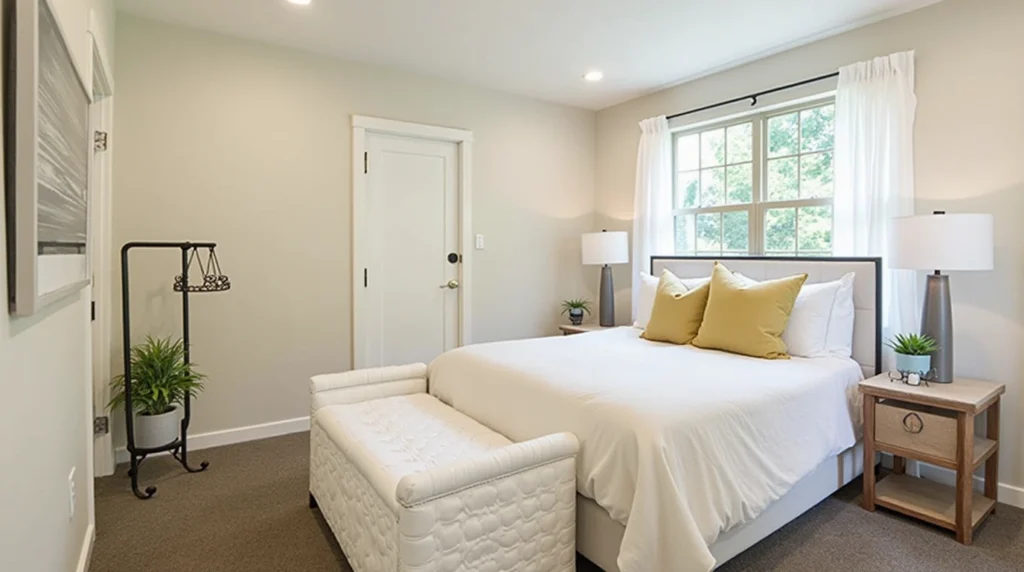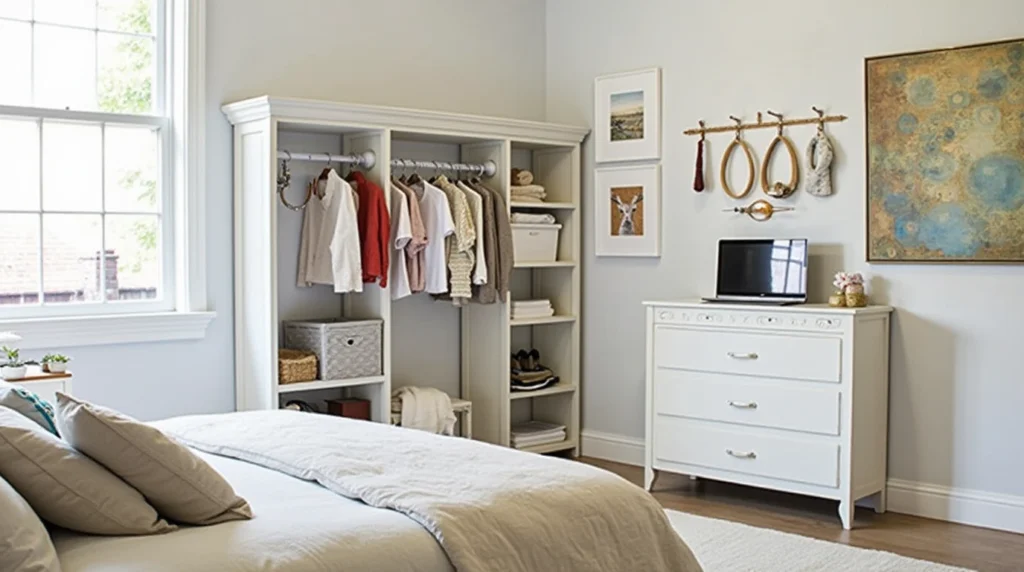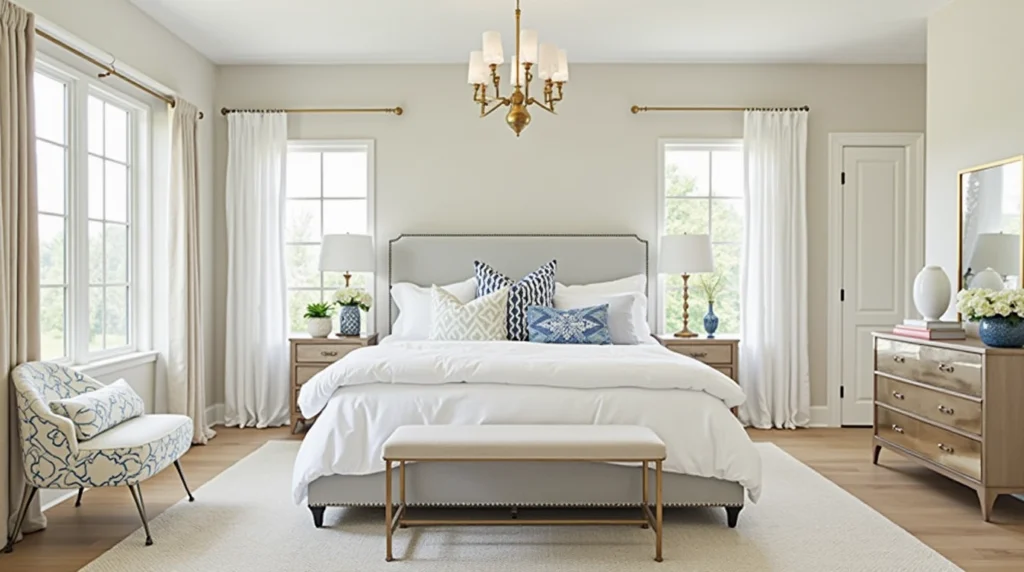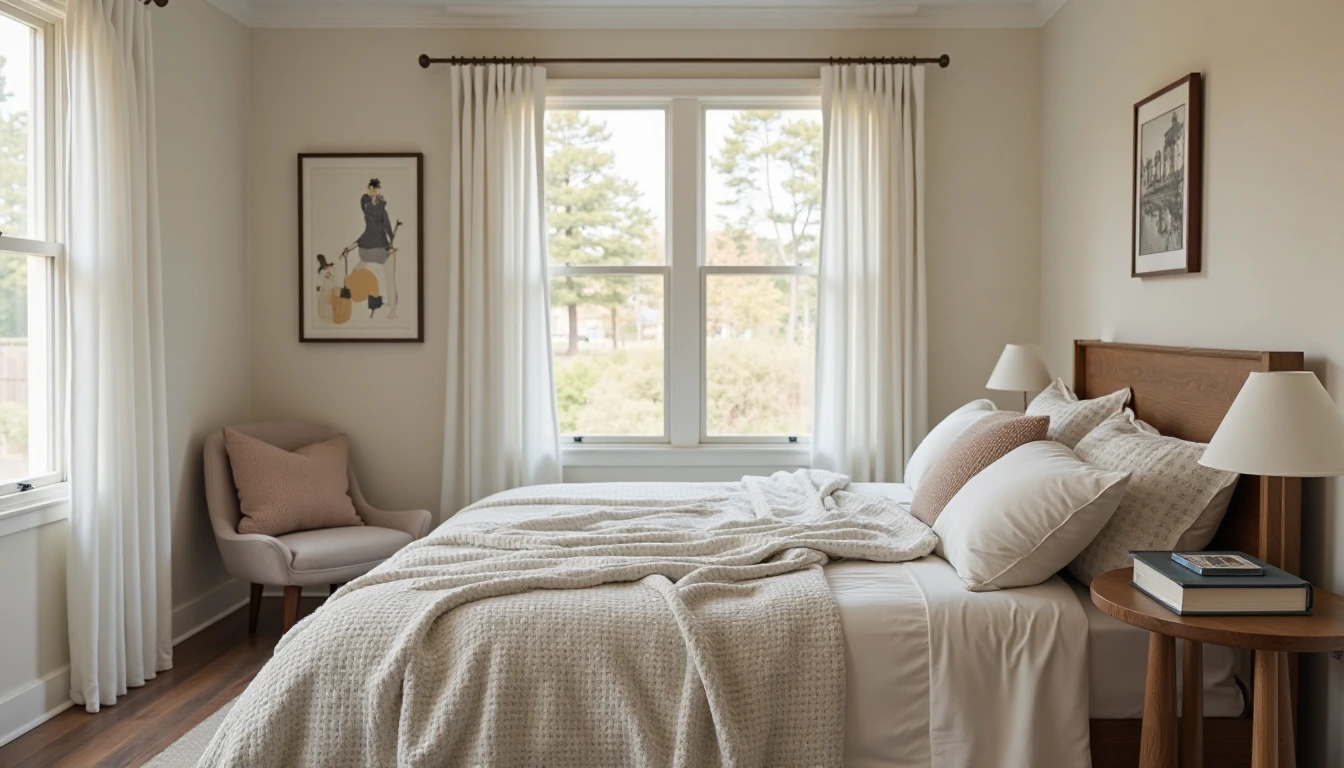Stylish Small Master Bedroom Design: The Ultimate Guide
In the realm of home design, few tasks are as common—or as satisfying to tackle—as crafting a stunning and functional master bedroom in a limited space. Whether you’re in a snug urban apartment, a modest starter home, or simply dealing with a smaller-than-desired room, the right master bedroom ideas and smart design strategies can turn a cramped area into a captivating retreat.
This comprehensive guide explores every aspect of small master bedroom design, from understanding the unique challenges of limited space to implementing clever storage solutions, selecting the perfect color palette, and bringing it all together with strategic lighting and accessories. By the end, you’ll be equipped with all the knowledge and inspiration you need to create a master bedroom that feels spacious, serene, and perfectly suited to your needs.
Table of Contents
Understanding the Challenges of Small Spaces

Living with a small master bedroom presents unique challenges that many homeowners and renters face daily. If you’ve ever felt frustrated by limited floor space, inadequate storage, or the feeling that your bedroom is more claustrophobic than calming, you’re not alone.
“The challenge of a small space isn’t about fitting everything in—it’s about creating room to breathe and live comfortably.” — Interior designer Sarah Richardson
Common challenges include:
- Limited floor space making furniture placement difficult
- Minimal storage options leading to clutter and disorganization
- Restricted movement around the bed and other furniture
- Poor lighting that can make the space feel even smaller
- Competing functions when the bedroom must serve multiple purposes
The good news? These challenges are far from insurmountable. Throughout this guide, we’ll address each one with practical, stylish solutions that don’t require expanding your square footage.
Space Planning & Layout: The Foundation of Good Design
The most crucial step in transforming a small master bedroom is thoughtful space planning. Before purchasing furniture or selecting paint colors, take time to understand your space and how to maximize every square inch.
Measuring and Mapping Your Space
Start by measuring your room’s dimensions, including:
- Wall-to-wall measurements
- Ceiling height
- Door and window placements
- Electrical outlets
- Fixed elements like radiators or built-ins
Create a simple floor plan on graph paper or use a digital room planner app. This visual reference will be invaluable as you plan your layout.
Optimal Bed Placement
In a master bedroom, the bed is naturally the focal point. Consider these options for placement:
- Center the bed on the longest wall — This traditional placement works well in rectangular rooms, creating balance.
- Corner placement — In extremely small spaces, tucking the bed into a corner can free up valuable floor space.
- Float the bed — If your room is square-shaped, floating the bed in the center with space to walk around it can create a luxurious feel despite size limitations.
Traffic Flow Considerations
Maintaining at least 24 inches of walking space around furniture is ideal. Map out traffic patterns to ensure smooth movement through the room, paying special attention to:
- The path from the door to the bed
- Access to closets and en suite bathrooms
- Space needed to open drawers and doors fully
Layout Options for Different Room Shapes
Long, Narrow Rooms:
- Place the bed on the short wall to break up the “bowling alley” effect
- Use the length for a small seating area or workspace if needed
Square Rooms:
- Center the bed with nightstands on both sides
- Use corners for additional storage or seating
Awkward Layouts:
- Embrace angled walls or nooks for built-in storage
- Consider custom furniture pieces that maximize difficult corners
Space-Saving Furniture Ideas: Choose Multipurpose Pieces

When every square inch counts, furniture selection becomes critical. The key is finding pieces that serve multiple functions without overwhelming the space.
Bed Options for Small Spaces
The bed typically occupies the most space in a master bedroom, making it your most important furniture decision.
Platform Beds with Storage:
- Drawers underneath provide significant storage without requiring additional furniture
- Clean, simple lines help maintain visual spaciousness
- Available in various styles from contemporary to traditional
Murphy Beds:
- Ideal for extremely small spaces or rooms that serve multiple purposes
- Today’s designs are sophisticated and easier to operate than older models
- Can include integrated shelving or desk space when folded up
Low-Profile Beds:
- Create the illusion of higher ceilings and more space
- Work particularly well with modern, minimalist design aesthetics
- Pair with wall-mounted lighting to eliminate the need for bulky nightstands
Nightstand Alternatives
Traditional nightstands can consume valuable floor space. Consider these alternatives:
- Floating shelves mounted at bed height
- Wall-mounted drop-leaf tables that can be folded when not needed
- Nesting tables that can be expanded when needed and tucked away when not
- Narrow console tables that provide surface space without depth
Streamlined Storage Options
Replace bulky dressers and armoires with these space-efficient alternatives:
- Tall, narrow dressers that utilize vertical space
- Under-bed storage containers for seasonal items
- Over-door hanging organizers for shoes and accessories
- Built-in wardrobe systems customized to your exact dimensions
Multi-Functional Furniture Ideas
Look for pieces that serve more than one purpose:
- Ottoman with storage that works as seating and storage
- Desk that converts to a vanity for dual functionality
- Bench with hidden storage at the foot of the bed
- Headboards with integrated shelving for books and decorative items
Vertical Storage Solutions: Look Up, Not Out
One of the most underutilized resources in small bedrooms is vertical space. By thinking upward, you can dramatically increase your storage capacity without sacrificing floor space.
Wall-Mounted Storage Systems
- Adjustable track systems with shelves, hooks, and cabinets that can be reconfigured as needed
- Floating shelves installed in a staggered pattern for visual interest and functionality
- Wall-mounted cabinets that provide closed storage for items you don’t want on display
Utilizing the Space Above Furniture
- Install shelving above the headboard for books and decorative items
- Mount cabinets above dressers for additional closed storage
- Use the space above doors for narrow shelving for rarely used items
Floor-to-Ceiling Solutions
- Custom built-ins that maximize every available inch
- Tall bookcases that draw the eye upward, creating the illusion of height
- Wardrobes with upper cabinets for seasonal clothing storage
Creative Vertical Storage Ideas
- Pegboard walls for customizable hanging storage
- Ceiling-mounted racks for items like hats or light blankets
- Wall-mounted jewelry organizers to keep accessories organized and on display
Color Palette for Small Spaces: Create Visual Expansion

The colors you choose for your small master bedroom can dramatically impact how spacious it feels. Strategic use of color can visually expand your space without moving a single wall.
Light and Bright: The Classic Approach
Light colors naturally make spaces feel more open and airy:
- Whites and off-whites reflect light and create a sense of openness
- Soft neutrals like beige, greige, and light gray provide warmth while maintaining spaciousness
- Pale pastels add subtle color without overwhelming the space
Monochromatic Color Schemes
Using variations of a single color creates cohesion and visual flow:
- Tone-on-tone layering with different shades of the same color
- Textural variations to add interest within a limited color palette
- Small contrasting accents to prevent monotony
Strategic Use of Darker Colors
Contrary to popular belief, dark colors can work in small spaces when used thoughtfully:
- Accent walls to create depth (especially behind the headboard)
- Dark ceiling paint in rooms with high ceilings to create coziness
- Rich colors in small doses through textiles and accessories
Color Zoning for Functionality
Use color to visually separate areas in a multipurpose bedroom:
- Different wall colors to define sleeping versus working areas
- Cohesive palette with subtle variations to maintain overall harmony
- Consistent flooring throughout to unify the space
“In small spaces, color should be used as a tool, not just a decoration. The right palette can visually transform your room’s dimensions.” — Bobby Berk, interior designer
Lighting Strategies: Brighten and Expand
Proper lighting is crucial in small master bedrooms, not just for functionality but for creating the illusion of more space. A well-lit room feels larger, while poor lighting can make even a decent-sized room feel cramped.
Layered Lighting Approach
Create a comprehensive lighting plan using all three main types:
- Ambient lighting — Overall illumination that fills the room
- Ceiling-mounted fixtures
- Recessed lighting
- Wall sconces that wash light up walls
- Task lighting — Focused light for specific activities
- Reading lamps
- Under-cabinet lighting
- Vanity lighting
- Accent lighting — Decorative elements that add atmosphere
- Picture lights
- LED strips behind headboards
- Table lamps with dimming capabilities
Space-Saving Lighting Fixtures
Choose fixtures that don’t consume valuable surface or floor space:
- Wall-mounted swing-arm lamps instead of table lamps
- Pendant lights from the ceiling instead of floor lamps
- Recessed lighting that doesn’t protrude into the room
- LED tape lighting tucked into molding or under furniture
Natural Light Maximization
Make the most of available natural light:
- Sheer window treatments that provide privacy without blocking light
- Light-reflecting window hardware that doesn’t obstruct glass
- Strategic mirror placement to bounce natural light deeper into the room
- Glass or translucent room dividers if needed to maintain light flow
Smart Lighting Technologies
Modern lighting technology offers space-efficient solutions:
- Programmable lighting systems that adjust throughout the day
- Motion-activated under-bed lighting for nighttime navigation
- Color-temperature adjustable bulbs to create different moods
- Integrated USB charging outlets in lighting fixtures to reduce cord clutter
Mirror Placement: Creating Optical Illusions
Mirrors are perhaps the oldest trick in the interior designer’s handbook for making spaces feel larger—and for good reason. Strategic mirror placement can visually double your space and enhance natural light.
Full-Length Mirrors
- Place opposite windows to maximize light reflection
- Use as closet or wardrobe doors to serve dual purposes
- Consider leaning floor mirrors to add depth without installation
Wall-to-Wall Mirrors
- Install mirror panels on one full wall to visually double the room size
- Use in narrow spaces to create the illusion of width
- Consider slightly antiqued or smoked mirror for a softer effect
Mirrored Furniture
- Mirrored nightstands reflect light without consuming visual space
- Dressers with mirrored panels appear less bulky
- Coffee tables or ottomans with mirrored tops reflect ceiling lights
Creative Mirror Applications
- Mirrored ceiling medallions around light fixtures
- Clustered small mirrors as wall art that also expands the space
- Mirrors with built-in lighting for functionality and space expansion
- Mirrored closet interiors to make storage spaces feel larger
Organization and Decluttering Tips: Less Is More
Perhaps the most important aspect of managing a small master bedroom is maintaining organization. Even the most beautifully designed small space will feel cramped if cluttered.
The Minimalist Approach
Embrace “less is more” as your guiding principle:
- Keep only what you truly need and love
- Implement a one-in-one-out rule for new purchases
- Regularly reassess possessions and donate unused items
Hidden Storage Solutions
Keep necessities close but out of sight:
- Under-bed storage containers on wheels for easy access
- Hollow ottomans for extra bedding or seasonal clothing
- Bed frames with integrated drawers for frequently used items
- Headboards with concealed storage compartments
Closet Organization Systems
Maximize existing closet space:
- Double-hang clothing rods to utilize vertical space
- Shoe organizers on doors or walls
- Adjustable shelving systems that can evolve with your needs
- Vacuum bags for seasonal clothing and bedding
Daily Maintenance Routines
Develop habits that prevent clutter accumulation:
- Spend 5 minutes each morning returning items to their homes
- Create a dedicated “drop zone” for daily items like watches and jewelry
- Implement a bedside catchall for essentials that won’t clutter surfaces
- Establish a seasonal purging schedule to prevent accumulation
Budget-Friendly Options: Style Without Breaking the Bank
Creating a stunning small master bedroom doesn’t have to cost a fortune. With strategic investments and creative DIY approaches, you can maximize both space and style on any budget.
Investment Priorities
Focus your budget on these high-impact elements:
- Quality mattress — Never compromise on sleep quality
- Functional storage solutions — Custom or semi-custom options for perfect fit
- Lighting — Good lighting makes everything else look better
Budget-Friendly Furniture Sources
- Secondhand marketplaces for solid wood pieces that can be refinished
- Flat-pack furniture companies that specialize in space-saving designs
- Floor models and warehouse sales for discounted high-quality items
- Vintage shops for unique, often smaller-scale furniture designed for older homes
DIY Projects for Small Spaces
- Floating shelves made from inexpensive lumber and brackets
- Headboard alternatives like wall decals or fabric panels
- Customized IKEA furniture hacks to fit your exact measurements
- Painted furniture transformations to unify mismatched pieces
Cost-Effective Decorating Ideas
- Removable wallpaper for instant impact without commitment
- Standardized frames with rotating artwork for seasonal changes
- Indoor plants that add life and filter air without major expense
- Textiles like pillows and throws that can be easily changed for style updates
Real-Life Examples & Case Studies: Inspiration in Action
Sometimes the best way to understand what’s possible is to see real-world examples. Here are several case studies of small master bedrooms that overcome common challenges with innovative solutions.
Case Study 1: The 10×10 Urban Apartment Bedroom
Challenge: Extremely limited space with no built-in storage and a need for work-from-home options.
Solutions Implemented:
- Wall-mounted Murphy bed with integrated desk that converts for daytime use
- Floor-to-ceiling built-in storage along one wall
- Monochromatic soft blue color scheme with white accents
- Mirror-backed sconces that provide light without taking up space
- Floating shelves above desk/bed area for books and decorative items
Outcome: A space that functions efficiently for both sleeping and working, with adequate storage for one person’s needs and a calm, airy aesthetic.
Case Study 2: The Awkward Attic Master Bedroom
Challenge: Sloped ceilings, limited headroom, and irregular wall angles.
Solutions Implemented:
- Low platform bed positioned where ceiling height is greatest
- Custom built-in storage units that fit precisely into knee walls
- Light neutral palette with a single deep blue accent wall
- Skylight with remote-controlled shade for natural light
- Strategic placement of mirrors on the few straight walls
- Wall-mounted lighting to eliminate need for floor or table lamps
Outcome: A cozy, nest-like space that embraces its architectural quirks while providing ample storage and a sense of greater space through light colors and strategic mirrors.
Case Study 3: The Long, Narrow Railroad Bedroom
Challenge: A 8×15 space with doors on both short ends, creating challenging traffic flow and furniture placement issues.
Solutions Implemented:
- Bed placed against the long wall to maintain traffic flow
- Built-in wardrobes with sliding doors (not swing-out) along opposite wall
- Light colors on three walls with a medium-toned accent color on headboard wall
- Floor-to-ceiling mirror on one short wall to visually widen the space
- Ceiling-mounted track lighting to eliminate need for bedside lamps
- Under-bed drawers for additional storage
Outcome: A functional space that accommodates necessary traffic while creating a sense of greater width through strategic use of color, mirrors, and furniture placement.
Case Study 4: The Multipurpose Guest/Office Master Bedroom
Challenge: A small second bedroom needed to function as both master bedroom and home office.
Solutions Implemented:
- Daybed with trundle for sleeping that converts to seating during the day
- Wall-mounted desk with fold-down surface that can be closed when not in use
- Color-coding system: blue elements for sleeping, green accents for working
- Rolling storage cart that can be positioned for either function
- Pegboard wall system for adaptable storage and display
- Strategic use of textiles and lighting to transition between functions
Outcome: A flexible space that successfully serves both purposes without feeling cluttered or compromised, with clear visual cues for each function.
Frequently Asked Questions
Q: What’s the minimum size for a master bedroom?
A: While building codes vary, most consider 70 square feet the absolute minimum for a bedroom. For a master bedroom, aim for at least 100-120 square feet to accommodate a queen bed and basic furniture. Remember, though, that good design can make even smaller spaces function well.
Q: How can I fit a king bed in a small master bedroom?
A: Before committing to a king bed, ensure you’ll have at least 2 feet of clearance around three sides. If space is tight, consider:
- A platform king bed without a footboard
- Wall-mounted nightstand alternatives
- Sliding closet doors or pocket doors that don’t require swing space
- Eliminating other furniture and maximizing vertical storage instead
Q: What’s the best wall color to make a small bedroom look bigger?
A: While light colors generally make spaces feel larger, the best approach depends on your specific room:
- For rooms with good natural light: Soft whites, pale blues, or light greens
- For rooms with limited natural light: Warm whites, soft grays with warm undertones
- For a cozier, enveloping feel: Consider darker colors but maintain consistency throughout
- Remember that high contrast between walls and trim can visually “chop up” a space
Q: How do I arrange furniture in an awkwardly shaped bedroom?
A: Start by identifying the most regular wall for your bed placement. Then:
- Use angled corners for storage or reading nooks
- Consider custom or built-in pieces for irregular walls
- Employ furniture with minimal footprints
- Use area rugs to define and regularize the functional space visually
Q: What type of bed should I choose for maximum storage?
A: For maximum storage, consider:
- Platform beds with 4-6 large drawers underneath
- Ottoman beds where the entire mattress platform lifts to reveal storage
- Murphy beds with integrated shelving systems
- Captain’s beds with drawers and potentially bookcase headboards
Q: How can I make my small bedroom look luxurious despite the size?
A: Luxury in small spaces comes from quality and attention to detail:
- Invest in high-quality bedding with subtle texture
- Choose a focal point like a statement headboard or dramatic lighting
- Add thoughtful layers of lighting at different heights
- Include one or two genuine antiques or high-quality pieces
- Pay attention to ceiling details with paint or subtle wallpaper
- Minimize clutter and maintain strict organization
Conclusion: Embracing the Potential of Small Spaces
A small master bedroom doesn’t have to mean compromising on style, comfort, or functionality. By thoughtfully applying the principles discussed in this guide—from strategic space planning and furniture selection to clever storage solutions and optical illusions—you can create a bedroom that feels spacious, serene, and perfectly tailored to your needs.
Remember that successful small-space design is about quality over quantity, careful editing, and making every element count. With intentional choices and creative thinking, your small master bedroom can become not just a place you sleep, but a sanctuary you truly love.
The most beautiful small bedrooms embrace their size rather than fighting against it, creating intimate, cozy spaces that feel like a perfect fit. By implementing the strategies in this guide, you’ll be well on your way to transforming your small master bedroom from a design challenge into your home’s most cherished retreat.
Ready to take your small master bedroom to the next level? Share your before-and-after transformations or ask specific questions in the comments below!







